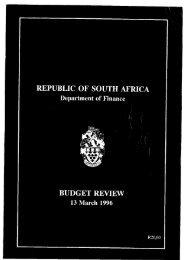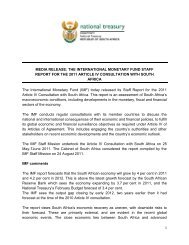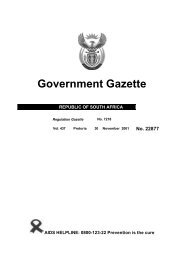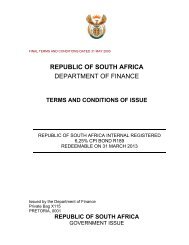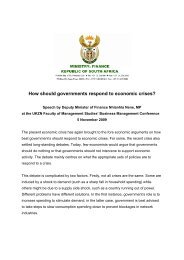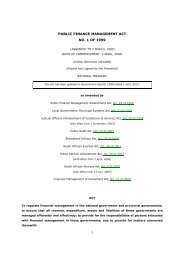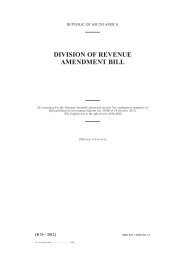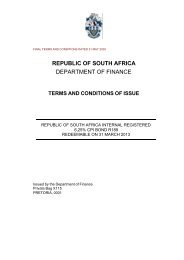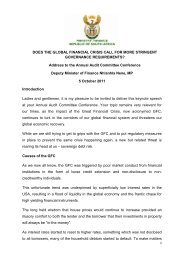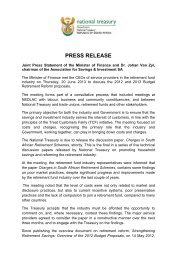1998 SOUTHERN AFRICA ECONOMIC ... - National Treasury
1998 SOUTHERN AFRICA ECONOMIC ... - National Treasury
1998 SOUTHERN AFRICA ECONOMIC ... - National Treasury
You also want an ePaper? Increase the reach of your titles
YUMPU automatically turns print PDFs into web optimized ePapers that Google loves.
TA N Z A N I A<br />
possesses an unspoilt 800km stretch of the Indian Ocean<br />
c o a s t l i n e, as well as the ‘spice islands’ of Zanzibar and Pe m b a .<br />
The government encourages private investment in ‘ u p - m a r ke t ’<br />
tourist deve l o p m e n t s ,including joint ve n t u res with the Ta n z a n i a<br />
Tourism Board .Tanzania re c e i ved 310,000 visitors in 1996 and<br />
tourism curre n t ly accounts for about eight percent of GDP, b u t<br />
the sector needs a substantial amount of investment befo re it<br />
can reach its full potential.<br />
T h e re is also potential for oil mining and exploration off the<br />
Tanzanian coast,as well as certain inland are a s .Drilling for oil has<br />
been taking place since 1952. One project which will soon be<br />
u n d e r w ay is the Songo Songo gas to electricity pro j e c t ,l o c a t e d<br />
on Songo Songo island.T h e re are special incentives available fo r<br />
companies planning to invest in oil exploration in Tanzania (see<br />
section on investment incentive s )<br />
I n f r a s t r u c t u re<br />
The national Urban Water Authority administers urban water<br />
s u p p ly, and regional water engineers service the rural systems<br />
t h rough local/village gove r n m e n t s .The UNDP estimates that<br />
about 38 percent of all Tanzanians have access to safe water and<br />
86 percent to sanitation.<br />
Pe t roleum meets nine percent of energy needs, w h i l e<br />
hy d roelectricity and coal provide the balance. Pe t roleum has to<br />
be imported thus absorbing large amounts of the country ’s<br />
fo reign exchange. T h e re is great potential for deve l o p i n g<br />
a l t e r n a t i ve sources of energy, n o t a b ly hy d roelectric powe r, c o a l ,<br />
natural gas and solar energy. Restrictions on power use are<br />
applied in drought times, reducing the efficiency of Ta n z a n i a ’s<br />
m a nufacturing sector. The privatisation of the Ta n z a n i a n<br />
Electricity Supply Commission should improve the reliability of<br />
p ower supply.<br />
Tanzania is well served by international, l a n d , sea and air<br />
t r a n s p o rtation ro u t e s . In most parts of the transport sector,<br />
major rehabilitation works are being undert a ke n .The size of the<br />
c o u n t ry and its low population density make maintenance and<br />
expansion of the transport infrastructure ve ry costly. A ro a d<br />
n e t work connects Tanzania with Ke ny a ,M a l aw i ,Z a m b i a ,U g a n d a ,<br />
Burundi and Rwanda, and any part of the country can be<br />
reached by the existing compre h e n s i ve road network of almost<br />
82,000 km of which 3,200 km are asphalt. M a ny roads are<br />
c u rre n t ly in poor condition and a major rehabilitation pro j e c t<br />
began in 1990.<br />
Tanzania Railw ays Corporation runs the 2,600 km system<br />
linking Dar es Salaam with the central and northern re g i o n s .<br />
The Tanzania-Zambia Railw ay Authority (TAZARA) operates<br />
1,860 km of track, 976 km of it in Ta n z a n i a ,which links Dar es<br />
Salaam with Kapiri Mposhi in Zambia’s Copperbelt. It is mainly<br />
used to transport Zambian copper to Dar es Salaam port and<br />
Zambian imports in the opposite dire c t i o n .The principal coastal<br />
p o rts are Dar es Salaam,Ta n g a ,L i n d i , Mtwara and Zanzibar. A l l<br />
p o rts are managed by the Tanzania Harbour A u t h o r i t y, e x c e p t<br />
for Zanzibar which is managed by the Zanzibar Po rt s<br />
C o r p o r a t i o n .<br />
International airlines operate in and out of Tanzania through Dar<br />
es Salaam and Kilimanjaro airport s . T h e re is a third international<br />
a i r p o rt on Zanzibar. T h e re are also several regional airports and<br />
nu m e rous landing strips for use by charter planes. Air Ta n z a n i a<br />
operates regular services to most regional towns and has<br />
scheduled flights to neighbouring countries and to the Midd l e<br />
E a s t .<br />
Te l e c o m munication facilities are available in most parts of the<br />
c o u n t ry, and Tanzania has an average of three telephones per<br />
1000 persons (1994), although the aim is to increase it to one<br />
per 100 persons by the year 2000. The telephone system in Dar<br />
es Salaam is being rehabilitated in a five year project due to end<br />
in <strong>1998</strong> and curre n t ly there is a surplus of exchange lines.<br />
Te l e p h o n e, f a x , t e l e x , expedited mail serv i c e, private couriers<br />
and cellular phones are av a i l a b l e.T h ree private companies have<br />
been granted licences as providers of cellular phones, w h i c h<br />
h ave proved ve ry popular. Tanzania has two earth satellite<br />
stations situated in Dar es Salaam.<br />
<strong>ECONOMIC</strong> OV E RV I E W<br />
Recent Ma c ro-Economic Deve l o p m e n t s<br />
M a c roeconomic performance in Tanzania for 1997 has been<br />
re l a t i ve ly satisfactory, despite the seve re drought and powe r<br />
s h o rtage experienced during the second and third quarter of<br />
1 9 9 7 , and the El Nino-induced floods in the latter part of the<br />
ye a r. Fo reign exchange re s e rves incre a s e d ,inflation dro p p e d ,t h e<br />
rate of GDP growth declined and the reve nue collection<br />
c o n t i nued to improve. Despite substantial pro g ress made in<br />
restructuring and stabilising the economy, the future outlook of<br />
the country ’s economy for <strong>1998</strong> is bleak given the effects of the<br />
o n going El Nino weather conditions being experienced<br />
t h roughout the country.Serious flooding has washed aw ay many<br />
roads and bridges, t h e re by seve re ly damaging the<br />
c o m munication netwo r k ,to the extent of halting movements in<br />
some areas of the country.As a consequence, the 1997/98 cro p<br />
is expected to perform far below targets.<br />
The overall real GDP growth for 1997 has been estimated at 4.0<br />
p e rc e n t ,c o m p a red with 4.2 percent growth re c o rded in 1996.<br />
G rowth in agricultural and manufacturing sectors for 1997 has<br />
been projected at 3.1 and 3.0 percent re s p e c t i ve ly, c o m p a re d<br />
with the previous ye a r ’s growth of 4.5 percent in the agricultural<br />
sector and 4.8 percent in the manufacturing sector.<br />
The Bank of Tanzania re c o rded considerable success in the<br />
pursuit of its monetary policy objectives during the first half of<br />
1 9 9 7 / 9 8 .On an annual basis, the money supply growth (M3)<br />
decelerated to 13.3 percent by December 1997 compared with<br />
18.1 percent re c o rded in Ju ly 1997.During the re p o rting period,<br />
net domestic assets of the banking system declined by TZS 7.5<br />
bn (USD11.6m), on account of a decrease of TZS 38.6 bn<br />
(USD59.9m) in domestic cre d i t ,coupled with an increase of T Z S<br />
31.1 billion (USD48.3m) in other items net.The decline in cre d i t<br />
was caused by considerable re p ayment to the banking system,<br />
by both the Government and the private sector.<br />
S i m i l a r ly, inflation exhibited significant improvements during the<br />
first half of 1997/98. Despite the food shortage experienced<br />
during the second half of 1997 when the road haulage system<br />
was brought to a standstill, inflation dropped to 15.2 percent by<br />
December 1997, c o m p a red with a high of 17.8 perc e n t<br />
re c o rded in Ju ly 1997.<br />
The overall weighted average annualised yield for all maturities<br />
fell from 14.8 percent in August 1997, to 10.5 percent in<br />
N ovember 1997, b e fo re picking up again to 11.4 percent by<br />
December 1997.This was attributed to increased competition<br />
in the marke t , and decline in tender size. M e a n w h i l e, t h e<br />
S t a t u t o ry Minimum Reserve Ratio of 12.0 percent that prev a i l e d<br />
t h roughout 1997 was reduced to 10.0 percent with effect fro m<br />
N ovember 1997.<br />
The government fiscal performance for the second quarter of<br />
1997/98 was satisfactory. R eve nue collections amounted to T Z S<br />
163.2 bn (USD266m) equivalent to 99.0 percent of the<br />
estimated reve nue collection for the period. S i m i l a r ly, t h e re was<br />
an increase in re c u rrent expenditure to TZS 161.2 bn<br />
(USD263m) resulting in an increase in expenditure on other<br />
goods and serv i c e s . The improvement in the fiscal position<br />
w a s m a i n ly attributed to the increased reve nue collection fro m<br />
enhanced corporate tax collection effo rt s , and from parastatal<br />
d i v i d e n d s .<br />
Net international re s e rves of the Bank of Tanzania increased and<br />
by December 1997 had reached USD 272.6 m. The Bank of<br />
Tanzania has targeted to build-up re s e rves equivalent to 20<br />
weeks of import re q u i rements by June <strong>1998</strong>.With re g a rd to the<br />
92



